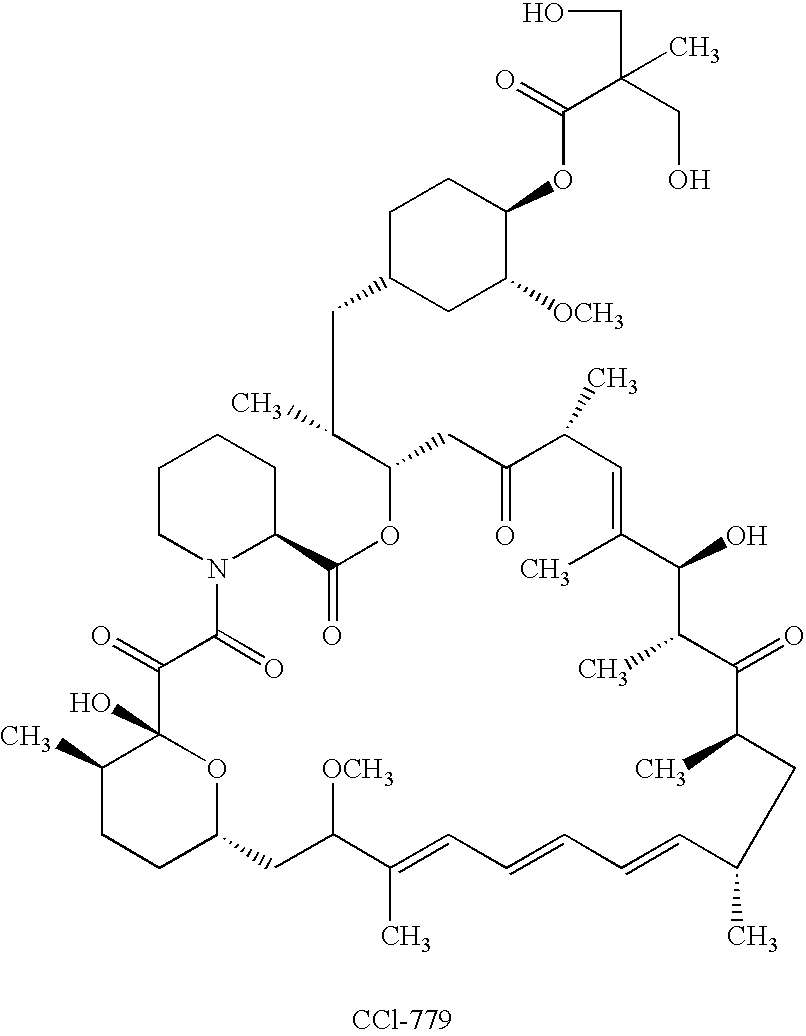Orally bioavailable CCI-779 formulations
a bioavailability and formulation technology, applied in the field of oral bioavailability cci-779 formulations, can solve the problems of low oral bioavailability, 779 exhibits aqueous instability, and has shown the potential to undergo oxidation, and achieves the effect of convenient and effective methods
- Summary
- Abstract
- Description
- Claims
- Application Information
AI Technical Summary
Benefits of technology
Problems solved by technology
Method used
Image
Examples
example 1
Directly Compressible Tablet Formulations Prepared By Employing Micronized CCI-779 And Poloxamer As Surfactant
[0046] The table formulations for this example are manufactured according to the following protocol.
[0047] Pass the poloxarner 188, microcrystalline cellulose (Avicel PH-112) and a portion of anhydrous lactose through a screen and blend. Mill the blend containing poloxamer with the help of a Fitz mill and transfer it to a V-blender of suitable size.
[0048] Preblend a portion of anhydrous lactose with micronized butylated hydroxyanisole, butylated hydroxytoluene, EDTA calcium disodium, hydrous, and citric acid anhydrous. Then add CCI-779 to this preblend, mix and add to the V-blender.
[0049] Take a portion of anhydrous lactose, croscarmellose sodium, and colloidal silicon dioxide (Aerosil 200) and pass through a screen, blend and transfer it to V-blender. Pass the remaining anhydrous lactose through a screen and transfer it to V-blender. Close the lids and blend the materia...
example 2
Directly Compressible Tablet Formulations Prepared By Employing Micronized CCI-779, Sodium Lauryl Sulfate And Povidone
[0050] The tablet formulations for this example are manufactured using the following protocol.
[0051] Microcrystalline cellulose (Avicel PH-112) and povidone K-25 are passed through a screen and transferred to a V-blender of suitable size. Micronized CCI-779 is preblended with a portion of lactose anhydrous separately, then passed through a screen and added to the V-blender. Sodium lauryl sulfate, croscarmellose sodium, silicone dioxide and a portion of lactose anhydrous are passed through a screen and transferred to the V blender. The remaining lactose anhydrous is passed through a screen and transferred it to V-blender and the lids are closed. The material is blended without activation of intensifier bar. Magnesium stearate is passed through a screen, premixed with a weight equivalent portion of powder, blended from V-blender, transferred to the lubricant premix t...
example 3
Bioavailability Study
[0053] A. Number Of Patients:
[0054] A total of 40 subjects, 38 men and 2 women, were enrolled in the study, and 35 subjects, 33 men and 2 women, completed the study (40 planned, 40 enrolled, 35 completed, 40 analyzed for safety, 35 analyzed for pharmacokinetics).
[0055] B. Duration Of Treatment:
[0056] Each completing subject participated in study procedures for approximately 43.5 days. The prestudy screening evaluation took place within 2 to 14 days before study day 1 of period 1.
[0057] C. Study Drug, Dose, And Mode Of Administration:
[0058] On day 1 of each of the 3 study periods, the subjects received a single oral dose of 1 of 4 treatments (treatments A, B, C, or reference).
[0059] Treatment A was CCI-779 25 mg tablet, containing micronized Poloxamer 188, manufactured essentially as described in Example 1. For the reasons illustrated below (including lower bioavailability), this Treatment is less desirable than prototypes B and C described herein.
[0060] ...
PUM
| Property | Measurement | Unit |
|---|---|---|
| particle size | aaaaa | aaaaa |
| particle size | aaaaa | aaaaa |
| particle size | aaaaa | aaaaa |
Abstract
Description
Claims
Application Information
 Login to View More
Login to View More - R&D
- Intellectual Property
- Life Sciences
- Materials
- Tech Scout
- Unparalleled Data Quality
- Higher Quality Content
- 60% Fewer Hallucinations
Browse by: Latest US Patents, China's latest patents, Technical Efficacy Thesaurus, Application Domain, Technology Topic, Popular Technical Reports.
© 2025 PatSnap. All rights reserved.Legal|Privacy policy|Modern Slavery Act Transparency Statement|Sitemap|About US| Contact US: help@patsnap.com

